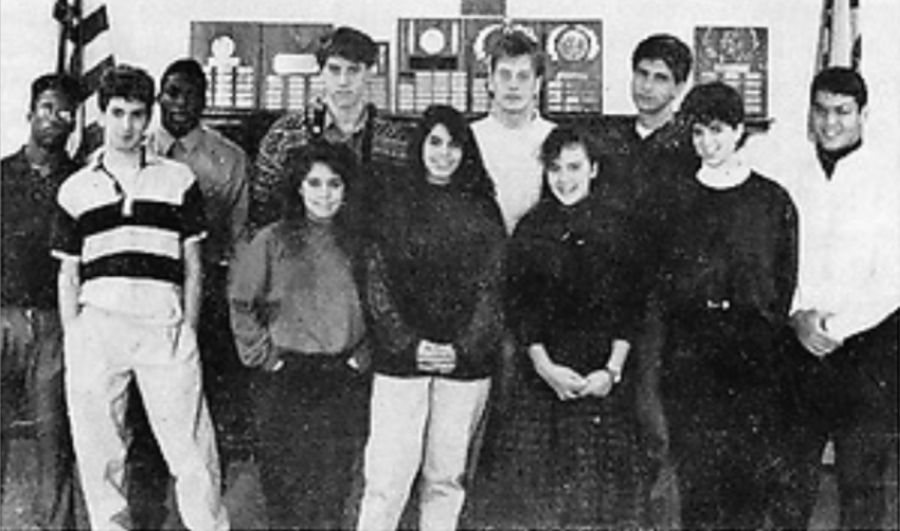What is ‘Appropriate Dress’?
January 3, 2023
Poly Prep’s dress code has been a constantly shifting policy in the last few decades, spurring discussions within the community. The loosening of the policy and current wording allows room for interpretation within the student body, but leaves some students confused about what the restrictions are and administration trying to draw the ever-changing line.
Head of Upper School Sarah Bates kicked off the year with an announcement in assembly specifying certain aspects of the dress code. Bates stated that midriff-revealing clothing was not appropriate for an academic setting. However, according to an email from Bates, she is not aware of any student being dress coded this year. Despite this, some students were confused about whether or not the administration was prohibiting clothing like crop-tops.
The current handbook states that students are expected to dress for a professional setting without any expression of profanity or discrimination. As stated in the school’s current Middle and Upper School dress code policies, “Students are expected to dress appropriately, in accordance with Poly’s values and academic purposes. Whether on campus or representing Poly at school-related events, students are expected to wear clothing that demonstrates respect for themselves, the School, and people around them.”
Both policies also allow students to express their own personal styles, but prohibit clothing that may objectify anyone or their identities, glorify violence, espouse hatred, or reflect drug, tobacco, or alcohol use. Both policies also state that “clothing should be of appropriate length and should not expose torsos or undergarments.”
The Middle and Upper School dress codes do contain some differences. While both age groups of students are not allowed to wear open-toed shoes, only the Middle School policy notes that students cannot wear hats, caps, or other head coverings, unless for religious reasons. In both age divisions, the school “has sole discretion to determine if a student’s attire adheres to the standards of appropriate dress.” Parents and guardians may be notified of dress code violations, and students may receive disciplinary action as determined by the school.
Bates noted that during COVID, the administration’s only goal was to get students to come to school. Kids wore jeans, crop tops, and pajama pants.
Bates also said that there was a push to update the Upper School dress code to align with the Middle School, since both divisions share a campus. She added that the code, which reads in part, “The expectation is that students come to school dressed for a professional, academic setting” is intended to allow personal freedom while also helping students learn what is and is not appropriate to wear in a wide range of situations.
“The dress code is really relaxed to be perfectly honest,” Bates said. “The most important elements of that are not wearing any language symbols or brands that would promote or espouse violence, drug or alcohol use, [or] any negative connotations towards someone’s identity. Basically don’t be offensive with the language or symbols.” Bates said that the policy said nothing about crop tops specifically, and that there would not be consequences for students who wear them to school.
Reflecting on the dress code announcement she made on the first day of school, Bates expressed that she wished to have laid it out differently. “I realize it’s November and I take full responsibility for not starting these conversations earlier,” Bates said. She said she was also trying to avoid targeting female-identifying students. “My personal philosophy is the ability to express yourself as an individual,” Bates said.
She connected her approach to the announcement back to her own high school experience. Scrolling through fashion blogs, Bates came to the realization that low-rise, a popular early 2000s trend, was quickly resurfacing. “I graduated high school in the year 2000, and it’s so fun to see those styles come back. Except the low-rise was giving me almost personal flashbacks to feeling how me and my friends felt, where the fashion and style wasn’t about the clothes. It was about the body that wore them,” Bates said. She further explained that “low-rise looks great according to society if you have a very specific torso. And then I started thinking about the very serious rise in disordered eating that we’ve seen from our students here at Poly, not just female students but male students as well. I started thinking, could school be one place where that’s not in your face all the time?”
Bates expresses that the goal of her announcement was not to target a particular gender. “I know you don’t see a lot of boys walking around their midriff hanging out, so I know it’s [leaning] more towards female-identifying students, which I’m conflicted and uncomfortable with,” Bates said.
In the near future, Bates hopes to make the process of changing the dress code a collaborative effort. “Policies are made to be examined, interrogated, dissected, evaluated to see, does this make sense for us as a community? If it does, great. If it doesn’t, let’s rewrite it,” Bates said. She also plans to meet with groups of female-identifying Upper School students to have these conversations. Bates added that she is also open to criticism and is genuinely eager to receive student feedback. “Can we collectively write the dress code together, or just understand what we mean by professional dress? I would love to work with the student body on writing the dress code and really have that be a collaboration more than ‘Ms. Bates says we can or can’t do this’. That’s not that’s not how I want to operate with you all,” Bates said.
Fixed rules for students’ wardrobe choices are not new. Previous dress code policies in Poly’s archives indicated that up until fifteen years ago students were limited to collars, blazers, dresses, skirts, and ties. Jeans were forbidden, and any violation resulted in punishment. According to the Poly Prep Student Handbook from 2004 to 2005, “Appropriate dress code and good grooming, as determined by the headmaster and the faculty, are the essential requirements of the Poly Dress Code…Students are always expected to be neat and clean.”
The Middle and Upper School Dress Code, which used to be split into three periods — fall, winter, and spring — required boys to wear collared shirts or turtlenecks (tucked in at all times), long pants (which had to have belt loops), and shoes or sneakers. In the fourth quarter, khaki shorts were allowed. All female students were required to wear dresses, skirts, or long pants, along with shoes or sneakers. According to the 2004-2005 dress code policy, “The blouse or shirt must be collared or a turtleneck. A sweater or blazer must be worn with long pants or skirts.” Sweatshirts, sweatpants, other athletic wear, pants with drawstrings, multicolored cargo pants, jeans or jean-cut pants or jackets, denim of any style, T-shirts, hats or caps (indoors), bare midriffs, skirts shorter than four inches above the knee, exposed underwear, tight or revealing clothing, exposed tattoos, flip-flops, and high heels were not permitted at any time. Any violations of the dress code could result in a student receiving a detention, being suspended from classes and afternoon activities, or even being sent home.
Chair of Visual Arts Laura Coppola, a Poly alum, recalled sexism around the dress code. “There were specific rules if you were a girl or a female-identifying [student]… If people disobeyed the dress code, teachers were much more active about giving detention (which doesn’t exist anymore).”
A 2002 Polygon article titled “Girls Don Ties to Protest Dress Code,” describes a peaceful protest carried out by female-identifying students in response to a winter dress code requiring blazers or sweaters. Students wore ties to school to demonstrate the dress code inequality. The protest sparked important conversations and heated debates surrounding not just the dress code itself, but larger gender inequality issues at school. Twenty years later, students and faculty are still having these discussions.
Some students felt Bates’ emphasis on midriff targeted female-identifying students, and others refused to follow it.
Sophomore Mika Magnes said “I didn’t follow it because I think it’s a little bit absurd and a lot of people…haven’t really been following it either, almost as a demonstration that we’re not going to listen to this almost sexist…dress code.”
Sophomore Emilia Fusaro feels like the notion that students should avoid crop tops is rooted in “a sexist ideology” that women are distracting to men.
Although sophomore Nico James and senior Whit Williamson agree that this suggestion targets female-identifying students, both said they do not think it is sexist, but just a reality of the different clothing preferences among genders. James said, “Appropriate length of clothing…applies mostly to women or to girls.” Williamson agreed that the dress code tends to apply more to female-identifying students than to others, noting that he thinks “Girls can get creative to a fault where it becomes inappropriate.”
Faculty are also conflicted about the dress code. “I feel like it’s okay to wear pajamas to school on pajama day, but not necessarily on other days,” Coppola said. “Pajamas are for your bedroom and your couch, and I think school should have different expectations when it comes to what to wear. I just feel like we should have conversations about what is appropriate.” Faculty noted a dress code may also minimize financial disparities. “There’s a lot of arguments to be made for a dress code helping there be less kind of anxiety around financial disparities,” said Chair of Upper School Deans Emily Gardiner.
In previous years, as stated by the 2004 to 2005 Poly Prep Student Handbook, “Form deans and the division head are the final arbiters of the Dress Code,” and take on the role of addressing dress code violations rather than teachers. “If I’m teaching you…my goals have nothing to do with your outfit at all,” Gardiner stated. “If there’s one thing you can say from the past 12 years, it’s like having a dress code involves so much talk,” Gardiner said. “It felt like the opposite of educational to me. Like we would have faculty meetings where we’d look up and think we just spent 30 minutes talking about how leggings are clothing now … and you sort of think, God, is that what we are coming to work for?”
“I don’t think I’ll ever be the kind of person who’s so wed to one thing that I’m unable to adapt or evaluate as our students’ need change,” Bates said.



























